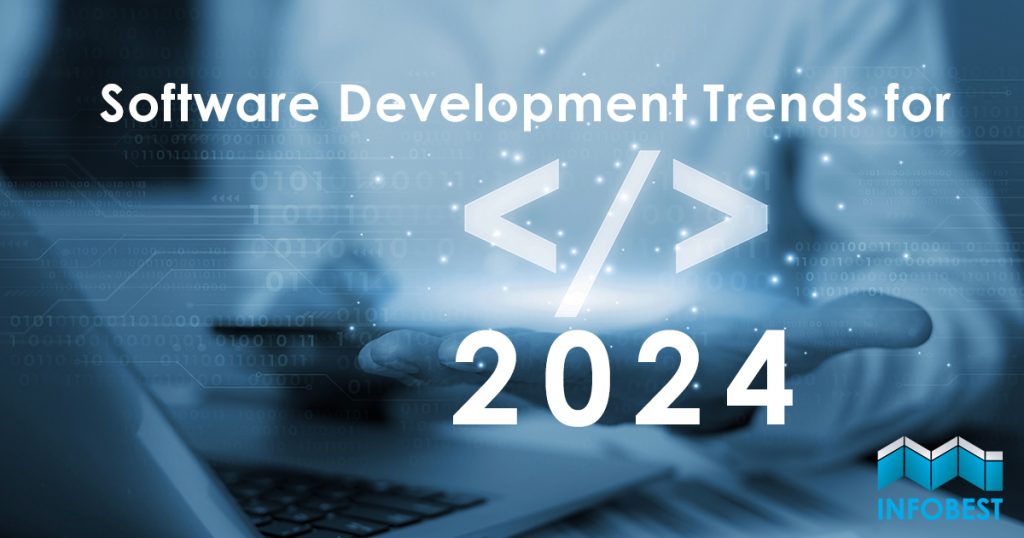In today’s fast-paced tech era, where innovation is the heartbeat of progress, software development remains at the forefront, steering the course of technological evolution. As we advance through 2024, the horizon of possibilities widens, and the dynamics of software development promise exciting changes.
The numbers tell a compelling story — with global spending on software development projects surpassing $500 billion, the industry reflects robust growth, underlining an escalating demand for IT solutions across diverse sectors (Statista). In this climate of rapid expansion, it is more critical than ever for companies to align themselves with the latest trends, ensuring not just relevance but a competitive edge in the evolving landscape.
From the promising ascent of Artificial Intelligence to the rapid growth of DevSecOps, the software development arena is undergoing transformative shifts. Feeling a bit uncertain about where your company stands amidst these changes or just eager to stay ahead of the curve in 2024? Fret not! We’ve curated a list of the most intriguing software development trends that will shape the year, providing you with insights to navigate the unfolding terrain of innovation and maintain your competitive edge. Let’s dive into the future together.
#1 Focus on Cloud Solutions
In the wake of unprecedented global events, 2022 highlighted the indispensable role of cloud services in maintaining business continuity. The ability to scale operations swiftly, whether surging or retracting, became a defining factor for companies across sectors. This adaptability was particularly evident in cloud-based platforms, allowing businesses to avoid unnecessary costs associated with traditional data center services during unpredictable market shifts.
The Dynamics of Cloud Excellence
Enter 2024, and the emphasis on cloud solutions has morphed into a broader commitment towards cloud excellence. It’s not merely about adopting cloud services; it’s about a strategic realignment of operations to leverage the full potential of cloud technology. From startups to established enterprises, businesses are prioritizing cloud integration to optimize resources, enhance operational efficiency, and fortify their stance against unforeseen disruptions.
Unveiling the Advantages
Why the emphasis on cloud solutions? The advantages are multifaceted. Flexibility, scalability, and cost-efficiency are at the forefront. The cloud allows businesses to dynamically adjust their infrastructure according to demand, ensuring resources are allocated where and when they are needed the most. This not only improves operational efficiency but also provides a robust foundation for innovation and growth.
The Path Forward
The trend of focusing on cloud solutions isn’t merely a reaction to past challenges; it’s a proactive strategy for the future. Businesses are recognizing that the cloud is not just a technological choice but a fundamental driver of business resilience and adaptability. Navigating the cloud-centric path requires a holistic approach, encompassing not just technology but a cultural shift towards embracing digital transformation.
#2 AI: A Dominant Force in 2024
In the dynamic realm of technology, artificial intelligence (AI) continues its unstoppable momentum, reshaping industries and daily life alike. The global AI market, valued at USD 454.12 billion in 2022, is poised to skyrocket to around USD 2,575.16 billion by 2032, according to Precedence Research. AI and machine learning have become ubiquitous, infiltrating almost every industry and even our homes, often operating quietly in the background, enhancing efficiency and user experiences.
The acceleration of AI adoption, fueled by the impetus of the COVID-19 pandemic, is set to persist, with profound implications for various sectors. In the banking industry alone, experts anticipate AI contributing an astounding $1 trillion in additional value annually.
AI’s Evolution in 2023 and Beyond
The year 2023 witnessed the prominence of generative AI, a transformative technology enabling AI to create texts, images, and even code. Innovations such as OpenAI’s ChatGPT garnered widespread attention, showcasing the creative capacities of AI and sparking dialogues about the boundaries of this technology.
Anticipating 2024: A Deeper AI Integration
Looking ahead to 2024, the trajectory of AI development points towards a more profound integration into software solutions. This integration goes beyond mere functionality, ushering in an era where applications not only perform tasks but learn, adapt, and provide users with increasingly personalized experiences. The year 2024 promises a new frontier in AI, where the boundaries between human and machine capabilities continue to blur, opening avenues for innovative solutions and unparalleled user interactions.
#3 Evolving Experiences: The Rise of Progressive Web Apps (PWAs)
In the dynamic world of web development, Progressive Web Applications (PWAs) have emerged as a game-changer, blending the best of both worlds—webpages and native mobile applications.
In simple terms, a PWA is like a webpage on steroids, offering all the perks of a native mobile app. Using a PWA means getting an enhanced version of your page with functionalities mirroring those of native apps, including offline operations, and if permitted, access to location, microphone, and camera. What’s more, PWAs function seamlessly and speedily, providing a consistent and efficient user experience.
The PWA Advantage
Gone are the days of investing money in developing separate apps for different operating systems. PWAs bridge the gap, offering users a native-like experience on any device. Whether accessed through a browser or as a mobile app, PWAs deliver a smooth experience, reducing data usage, enabling automatic upgrades, and expediting development timelines.
Google’s Stamp of Approval
Google, a leading force in the tech realm, has championed the creation of PWAs, dubbing them the “future of software.” This endorsement reinforces the significance of PWAs in the evolving landscape of software development.
Streamlined Development, Enhanced User Experience
PWAs not only enhance user experiences but also streamline development processes. They serve as a cost-effective solution, eliminating the need for separate mobile apps for specific operating systems. Built using common languages like JavaScript, CSS, and HTML, PWAs can operate on any platform with a web browser. As we move into 2024, the use of PWAs is expected to rise, reflecting the industry’s acknowledgment of the significant benefits they bring—cost savings, improved customer engagement, and a streamlined approach to development.
#4 Python and JavaScript: The Dynamic Duo of Programming Dominance
In the ever-evolving realm of programming languages, the ascendancy of Python and JavaScript is more than just a trend—it’s a testament to their enduring popularity and versatility.
Why are Python and JavaScript stealing the programming limelight in 2024? Well, for starters, they are easy to learn and use, making them favorites among developers. Python’s extensive use in data sciences and various other fields, coupled with JavaScript’s status as the go-to language for development beginners, ensures their continued demand.
Python Dominance Unveiled
Python’s reign as a dominant programming language is far from fading. Renowned for its simplicity, versatility, and robust library support, Python finds applications in web development, data analysis, artificial intelligence, and scientific computing. According to the PYPL index, measuring the frequency of language tutorial searches on Google, Python stands tall as the most popular programming language with an impressive growth rate of 19%.
In the 2023 Stack Overflow survey, Python emerges as the most desired language for developers to learn, surpassing Java for the first time since 2012. Not just confined to web app development, Python has become the language of choice, securing the TIOBE Programming Language of the Year three times in five years—a prestigious recognition for the language with the largest annual increase in ratings. Python’s extensive library range, seamlessly integrating into code and scaling to larger applications, offers boundless possibilities for both web and desktop app development, including system operations.
As we explore the programming landscape of 2024, it’s clear that Python, alongside the notable increase in Rust adoption, is steering the course of programming dominance, offering developers unparalleled flexibility and robust solutions.
#5 IoT Applications: Shaping the Future of Connectivity
In recent years, the Internet of Things (IoT) has emerged as a pivotal force, seamlessly connecting diverse devices and streamlining communication across industries. Beyond traditional gadgets, the IoT ecosystem spans a broad spectrum, from everyday items to substantial machinery, all interwoven into the fabric of the Internet. What’s noteworthy is that many of these interconnected devices are not just smart; they boast artificial intelligence, endowing them with the ability to make autonomous decisions.
The Diversity of IoT Impact
Businesses around the globe are reaping the rewards of IoT, enhancing operational efficiency and seamlessly integrating wearables and connected devices into our daily lives. This trajectory is set to intensify in 2024 as the line between the physical and digital realms continues to blur.
Projections from Forbes paint a vivid picture—by the end of 2024, the Internet of Things (IoT) is expected to surpass a staggering 207 billion interconnected devices, creating a global network that extends beyond gadgets to include a myriad of tools, toys, and appliances.
Harvesting the Power of IoT
IoT technology empowers businesses to optimize operations, utilize resources more efficiently, and elevate the overall user experience. However, fully unlocking IoT’s potential requires skilled software developers. These experts are instrumental in crafting robust, secure, and scalable applications that facilitate data collection, analysis, and process automation.
In this era of IoT innovation, the future is interconnected, offering unprecedented possibilities for businesses to thrive in the digital age.
#6 Elevating Success: The Crucial Role of UX in Software Development
Software development isn’t just a puzzle of functionality; it’s a canvas where usability takes center stage. Whether dealing with small-scale applications or complex systems, the ability for users to easily navigate and comprehend operations has become paramount.
The Significance of UX
User experience (UX) has evolved into a critical factor influencing the success of software applications. Beyond mere aesthetics, it encompasses how intuitively users can operate and derive value from a product. In the current landscape and extending into 2024, companies recognize that a positive UX is not just a bonus; it’s a fundamental aspect that determines user satisfaction and, consequently, the success of a software product.
Engineering Focus on User-Centric Design
Looking ahead, engineers will find themselves increasingly tasked with focusing on the realm of UX. This means not only delivering functional features but ensuring that the user journey is seamless, intuitive, and delightful. The emphasis on UX extends beyond aesthetics; it delves into the very core of how users interact with and experience software.
2024: A Dynamic in Software Development
In the realm of software development, 2024 is poised to be a monumental year marked by continuous innovation and transformative advancements. The developments we’ve explored, from cloud solutions and the unstoppable surge of AI to Python and JavaScript dominance, IoT applications, and the ascendancy of Progressive Web Apps (PWAs), collectively signal a dynamic and interconnected digital future.
As companies strategically embrace digital acceleration, reshaping their technological approaches to align with financial, societal, and customer care goals, the upcoming year promises seamless integration of technology with overarching business objectives. This convergence lays the foundation for remarkable results, defining 2024 by adaptability, user-centric solutions, and groundbreaking advancements. In a landscape where technology is the catalyst for change, 2024 stands ready to usher in a new era of possibilities and achievements in software development.

